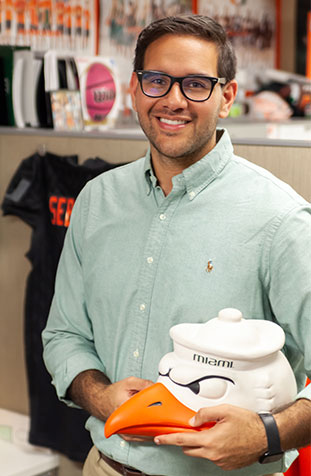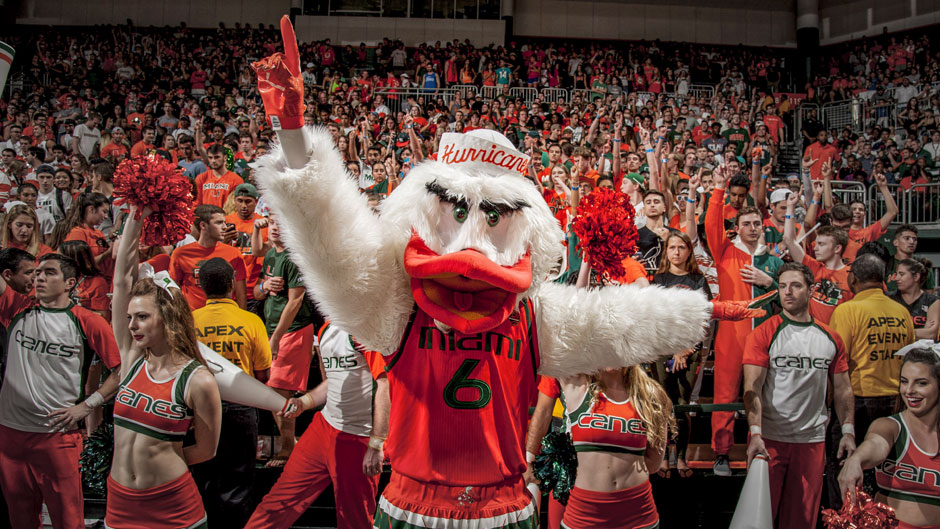You know him. You love him. He’s everywhere, and he’s the U’s biggest secret (at least until graduation day). Wings down, he’s one of the chillest birds anywhere, the embodiment of swagger and arguably the “best mascot in all of college athletics.” Sebastian the Ibis is a lot of bird to handle, yet handling these birds is Alejandro Rengifo’s job.

Rengifo, B.A. ’12, M.A. ’13, has been the Sebastian “handler” for the past four years as part of his duties as associate director of marketing for UM Athletics. A South Florida native, Rengifo attended the U intent on becoming a doctor but, while a marketing intern with athletics, a new passion ruffled his feathers. He went on to earn his master’s in sports administration, then accepted a position with Boston College. Rengifo had only been in the northlands a few months when his former supervisor called: “I know you realize the importance of the U’s mascot program—and there’s a spot for you.”
Rengifo’s responsibilities entail training and grooming the six to seven Sebastian mascots each academic year to help them evolve as freshman hatchlings just learning the ropes to full-fledged Threskiornithidae—or family of birds—ready to rock the University crowds. Additionally, he oversees marketing for the baseball and soccer programs, and a student liaison for Category Five.
“My role as the Sebastians' handler includes managing all of their schedules for the different events—weddings, bar mitzvahs, sporting events to make sure they have everything they need to be successful.
Rengifo's involvement starts with tryouts in late summer. Yet just what does he and the team of marketing interns look for from the candidates?
“It really is that diamond in the rough,” he says. “Sometimes the newbies are just not as energetic as we’d want. You have to really have a love for the U, really put it out. We put them in the suit and then in different situations—dealing with a scared child, giving out T-shirts, UM just scored the winning touchdown now what is Sebastian going to do?
“Sebastian is a male bird and he’s really got to have that swagger quality. You have to express yourself without speaking. So we teach them those things and get a gauge if they’re comfortable.”
Kevin Weaver, B.B.A. '17, assistant director Annual Giving, Young Alumni and Student Philanthropy, "Sebastian" 2014-17.
Favorite memory: Running through the smoke then doing a spell-out at midfield at the 2016 FSU game at home. It was a prime-time night game—gives me chills just thinking about it.
Biggest take-away: My freshman year I tried out but didn't get it, though one of my best friends did. I decided to try out again the next chance and it was the best decision; it taught me to never let go of committing to what I really wanted to do.
Practice makes perfect
Incoming Sebastians train by shadowing some 25 to 30 events over the fall semester so that by Homecoming in early December they’re ready for a solo fly. By springtime, these birds are really spreading their wings.
For private events in Miami-Dade County, Sebastian fetches $321 per hour plus mileage for a two-hour maximum appearance, while nonprofits and UM-affiliated campus groups get him for $100 per hour for that same two hours. Sebastians earn a modest stipend per semester, tips at events, and a few perks such as the chance to register early for classes, in exchange for the 10 hours or so they invest in time weekly. “Mostly they get a tremendous amount of experiences representing the U,” explained Rengifo.
Adrian Nuñez, B.B.A. '18, community engagement coordinator, Office of Government and Community Relations, “Sebastian” September 2015-May 2018
Favorite memory: “Traveling with the team for away games and one time we flew to St. Louis where we filmed a three-minute video with the Buffalo Wild Wings company that was posted on Facebook.
Biggest take-away: “I learned so much about logistics and communications. For homecoming alone had to schedule being in 50 different places.”
A long way from “Icky”
The Ibis was adopted as school mascot in 1926 when the University first launched, yet it wasn’t until the 1950s that the bird really broke out of its shell. In 1957 San Sebastian Hall, a residence hall on campus, sponsored an ibis entry in the homecoming celebration and the following year student John Stormont glued, sewed, and pinned together the first rendition, which debuted as “Icky.” A naming contest soon after selected “Sebastian” after the residence hall where he was born.
Yet it was John Routh, today the executive director of the UM Sports Hall of Fame, whom many credit with creating the Sebastian image that we know and love today. Routh, a “Sebastian” from 1984 to 1992, joined the U after graduating from South Carolina where he’d performed as “Cocky,” that school's gamecock mascot with its supersized hands and feet.
When he first donned the Sebastian outfit on a sweltering spring day, Routh knew some changes had to be made. He proposed a redesign with flexible beak and a lighter, airier outfit, then inserted a life preserver to pump up the chest. “I felt tough,” Routh remembered.
John Routh, executive director UM Sports Hall of Fame, "Sebastian" 1984-92.
Favorite Sebastian moment: 1989 Miami (#7) vs. Notre Dame (#1) in the Orange Bowl. “My whole family was watching in the audience, and I went to midfield and did the ’Canes spell-out for the first time. I had the whole stadium in my hands—and knew in that moment that we had a new tradition.”
Biggest takeaway: The impact of "Sebastian" as a goodwill ambassador. "I still remember the letter I received from a mom who'd lost her son to cancer. I'd visited him in the hospital shortly before his death, and he remembered it as his "last happy day."
Keep your beak shut
Protecting the identity of Sebastian is an important aspect of the mystique surrounding this mythical marsh bird. “It’s obviously a secret involvement that no one knows until graduation day,” Rengifo explained. “So Sebastians are encouraged not to tell anyone their secret. If people know they tried out, they can admit to that, but not that they’ve been selected.”
Rogelio Gonzalez, B.A. ’18 and currently pursuing his master's in Biomedical Sciences, “Sebastian” 2015-18
Favorite memory: “In my junior year during orientation, there were so many incoming freshmen who didn’t know about the culture of U, didn’t know about Sebastian, and they were meeting me for the first time, all wanting to take pictures, wanting to talk to me. I watched how the counselors expressed their love for the U and for Sebastian—it was such an incredible feeling to be part of the U and the student body where everyone is interconnected.”
Biggest take-away: “Improvement. Up until my last day, I was always working on my routine, trying to do better, to make the character the best possible.”
One size fits all
There is just a one-size Sebastian outfit. So individuals taller than 6’3” or shorter than 5’8” need not apply. The head itself weighs a bit over 10 pounds and, while certainly hot in the Miami heat, the mesh torso does allow for ventilation.
“As the year goes on, I’ve seen them so much I can tell who’s in the suit based on the body type. After a while, I don’t see them as Sebastians anymore, but instead they’re students that I’ve gotten to know and seen grow through the character that they represent.
“And when they’re getting compliments and the emails come in, it really means a lot to me because it means these kids are doing a great job.”
Watch: Sebastian Through the Years

